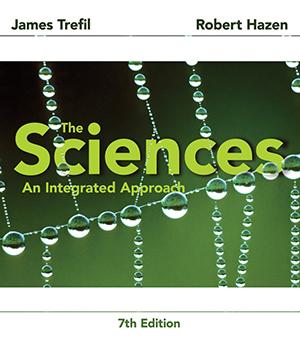
The Sciences: An Integrated Approach, 7th Edition
Building on the extraordinary success of eight best-selling editions, this Ninth Edition of Materials Science and Engineering continues to promote student understanding of the three primary types of materials (metals, ceramics, and polymers) and composites, as well as the relationships that exist between the structural elements of materials and their properties.
WileyPLUS is a research-based, online environment for effective teaching and learning. WileyPLUS packed with interactive study tools and resources—including the complete e-textbook—to give students more value for their money.
Schedule a Demo Sign Up for a Test Drive Adopt WileyPLUSWant to learn more about WileyPLUS? Click Here
The Science of Life
To help show the interdisciplinary nature of the many concepts introduced in the text, sections on living things have been included in most chapters. The chapters that emphasize principles specifically related to life are at the end of the book, but the biological examples appear throughout.
The Ongoing Process of Science
Science is a never-ending process of asking questions and seeking answers. In these features, some of the most exciting questions currently being addressed by scientists are examined.
Mathematical Equations and Worked Examples
Whenever an equation is introduced, it is presented in three steps: first as a sentence, second as a word equation, and finally in its traditional symbolic form. In this way, students can focus on the meaning rather than the abstraction of the mathematics. An appendix on English and SI units is also included.
Technology
The application of scientific ideas to commerce, industry, and other modern technological concerns is perhaps the most immediate way in which students encounter science. In most chapters, examples of these technologies such as petroleum refining, microwave ovens, and nuclear medicine are included.
Science by the Numbers
To help students understand the importance of simple mathematical calculations in areas of magnitude, several nontraditional calculations have been incorporated. For example, how much solid waste is generated in the United States, how long it would take to erode a mountain, and how many people were required to build Stonehenge.
Return to the Integrated Science Question
Each chapter opens with an Integrated Science Question that draws from the many branches of science discussed in the chapter. This question is revisited at the end of the chapter to illustrate how the material draws together to answer this question, thus creating a problem-solving framework for students to apply to future questions.
- Reliable tools and resources reinforce course goals inside and outside of the classroom. Instructors have the ability to easily identify those students who are falling behind. Media-rich course materials and assessment content are provided, including Instructor’s Manual, Test Bank, PowerPoint Slides, Learning Objectives, Solutions Manual, Study Guide, Computerized Test Bank, Pre− and Post−Lecture Quizzes, and more.
- Virtual Discovery Labs bring select core concepts to life in an online lab setting. Select text concepts are illustrated using flash animation, designed for use in classroom presentations.
- Line illustrations, photos, and tables in jpeg files and PowerPoint format are available both on the Instructor Companion Site and within
- WileyPLUS.
- Biology Visual Library containing all of the line illustrations in the textbook in jpeg format, as well as access to numerous other life science illustrations from other Wiley texts is available in WileyPLUS and on the Instructor Companion Site.
- The complete digital textbook saves students up to 60% off the cost of a new printed text.
- Question assistance is provided, including links to relevant sections in the online digital textbook.
- Students get immediate feedback and proof of progress, 24/7.
- Integrated, multi-media resources—including MP3 downloads, visual exhibits animations, demonstration problems, simulations, and more—provide multiple study paths and encourage more active learning.
- Discovery Labs provide students with additional real-world science applications.
- The labs may be conducted in a class or lab or may be assigned to complete at home.
- Animations illustrate select text concepts. Science in the News Video Clips are linked right into the digital book in WileyPLUS for easy in-context access to give students a look into how science works in the real world.
Instructor Resources
Student Resources
James S. Trefilearned his Ph.D. in Physics at Stanford University in 1966 and is the author of more than thirty books. Much of his published work focuses on science for the general audience. Dr. Trefil has previously served as Professor of Physics at the University of Virginia and he now teaches as Robinson Professor of Physics at George Mason University.
Robert M. Hazen, research scientist at the Carnegie Institution of Washington’s Geophysical Laboratory and Clarence Robinson Professor of Earth Science at George Mason University, received his B.S. and S.M. in geology at the Massachusetts Institute of Technology (1971) and his Ph.D. at Harvard University in earth science (1975). After studies as NATO Postdoctoral Fellow at Cambridge University in England, he joined the Carnegie Institution’s research effort. Hazen is author of more than 350 articles and 20 books on science, history, and music.
Chapter 1: Science: A Way of Knowing
Chapter 2: The Ordered Universe
Chapter 3: Energy
Chapter 4: Heat and the Second Law of Thermodynamics
Chapter 5: Electricity and Magnetism
Chapter 6: Great Ideas
Chapter 7: Theory of Relativity
Chapter 8: The Atom
Chapter 9: Quantum Mechanics
Chapter 10: Atoms in Combination
Chapter 11: Materials and Their Properties
Chapter 12: The Nucleus of the Atom
Chapter 13: The Ultimate Structure of Matter
Chapter 14: The Stars
Chapter 15: Cosmology
Chapter 16: Earth and Other Planets
Chapter 17: Plate Tectonics
Chapter 18: Earth’s Many Cycles
Chapter 19: Ecology, Ecosystems, and the Environment
Chapter 20: Strategies of Life
Chapter 21: The Living Cell
Chapter 22: Molecules of Life
Chapter 23: Classical and Modern Genetics
Chapter 24: The New Science of Life

